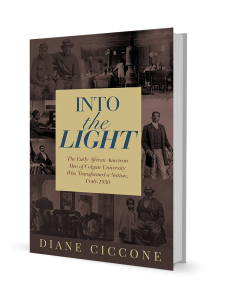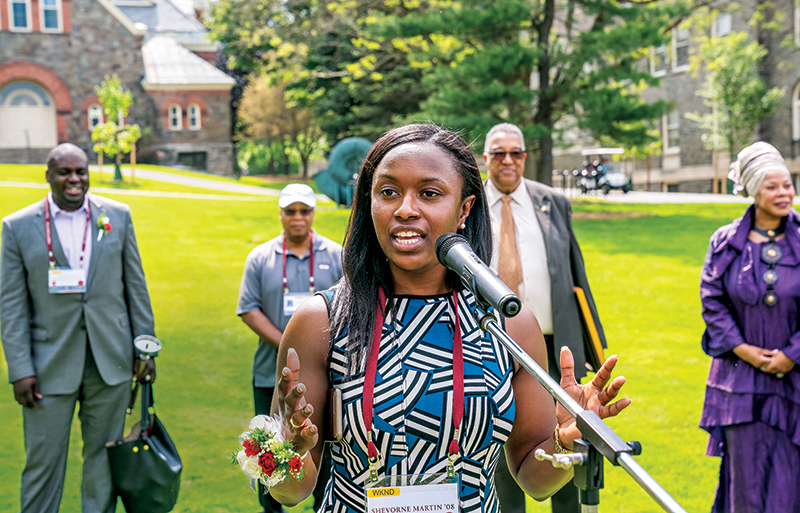Come One, Come All
May 30–June 2, 2019
The vista from the top of Colgate University’s hill is as arresting as the view from the bottom. Equally beautiful, they differ merely in perspective.
Similarly, the fondest recollections of Colgate University’s Bicentennial All-Class Reunion might differ among the almost 5,000 alumni, family members, and friends who attended the event May 30–June 2. Yet, all of those memories, full of joy and deep connection, were made to last a lifetime.
For class years ending in four and nine, it was a chance to sit under the tents on Whitnall Field or at class dinners in the Village of Hamilton, catching up on personal and professional news.
If you were a member of Konosioni, celebrating its 85th anniversary, you might have focused on University traditions, like the torchlight procession, led this year by President Brian W. Casey and Board of Trustees members. For 90 minutes, as the sunlight dwindled behind Taylor Lake, alumni streamed from the Academic Quad to Whitnall Field, carrying the light of knowledge on brass torches, made possible through the generosity of classmates.
If you were a Swinging ’Gate — a member of the University’s female a cappella group founded 45 years ago — you would have spent the weekend responding to the call of the pitch pipe.
Meanwhile, members of Thought Into Action celebrated 10 years mentoring student entrepreneurs, and the Alumni Council honored a century of work on behalf of the community of graduates, now more than 32,000 strong.

Ron Hoham (far right), biology professor emeritus, leads a walking tour of the campus landscaping. Photo by Andrew Daddio
During its Bicentennial year, Colgate vowed to look back on a proud history and forward to an ambitious future. Alumni had the chance to do the same during reunion weekend. Friday morning, former University trustees James Allen Smith ’70 and Diane Ciccone ’74, P’10 signed copies of their new books, each chronicling Colgate’s past.
In separate Reunion College sessions, faculty members provided further detail on the Robert Hung Ngai Ho Mind, Brain, and Behavior Initiative and progress on campus planning around the arts, creativity, innovation, and design — a conversation that now includes the performing arts, University museums, multiple academic departments, Thought Into Action, and other campus partners.
“When I was in college, there was a focus on rational thought. You read books, thought about them, then came back and talked about them, and that is a valuable way of learning,” Professor Lesleigh Cushing, associate dean of the faculty, said. “But people didn’t focus on learning with your body, with your hands. Now, the conversation has shifted. How do we create students who learn holistically through their bodies?”
Other Reunion College events featured alumni talking about team building, mindful storytelling, founding craft breweries, and more.
Memories of all kinds, collected by the thousands, were made possible by staff in alumni affairs with support from colleagues in the advancement office and across campus. No matter the class year or affiliation, the effort — years in the making — was both a rally and a rallying moment for an academic community on the move.
Invoking words that he gives to first-year students during convocation, Casey said, “I want to leave you with these lines: ‘Make no small plans here. Have no small dreams.’”
President Casey Presents Third-Century Plan
Alumni packed the chapel and overflow rooms across campus while others watched from around the world via Livestream as President Brian W. Casey delivered an address about the Third-Century Plan on the Saturday morning of reunion.
“We knew, when we began the planning process, that the trick was not to try to change Colgate, but to make it better.”
— Brian W. Casey
The newly approved plan is a long-term framework to guide the University as it pursues its mission at the highest possible level and becomes an even greater version of itself. “We knew, when we began the planning process, that the trick was not to try to change Colgate, but to make it better,” Casey said.
He described the elements of the plan, based on Colgate’s most distinctive characteristics, and outlined the first steps that the University will take toward implementation. Those steps include the elimination of loans for students with family incomes below $125,000; expanded support for professors, particularly junior faculty members; a second Hamilton Initiative, including a renovation of the University’s golf course; the pursuit of a plan for arts, creativity, innovation, and design; and the implementation of the new Robert Hung Ngai Ho Mind, Brain, and Behavior Initiative.
Stay tuned: Colgate Magazine will delve further into the Third-Century Plan in the autumn issue.
Into the light
Diane Ciccone ’74, P’10 Rediscovers Colgate’s African American Past
 Jonas Holland Townsend was the first African American to attend this institution, in 1840. Henry Livingston Simpson was the first African American to graduate, in 1853. Five black college presidents came from Colgate. Diane Ciccone ’74, P’10 details revelations such as these — and the histories of pioneering black men — in her new book Into the Light: The Early African American Men of Colgate University Who Transformed a Nation, 1840–1930.
Jonas Holland Townsend was the first African American to attend this institution, in 1840. Henry Livingston Simpson was the first African American to graduate, in 1853. Five black college presidents came from Colgate. Diane Ciccone ’74, P’10 details revelations such as these — and the histories of pioneering black men — in her new book Into the Light: The Early African American Men of Colgate University Who Transformed a Nation, 1840–1930.
Ciccone herself is a Colgate pioneer — a member of the first graduating class of women, the first black woman on the Board of Trustees (1993–2000), and co-founder of the Alumni Of Color organization. Colgate has recognized her with a Maroon Citation and the Wm. Brian Little ’64 Alumni Award for Distinguished Service and one of the Residential Commons is named for her.
Ciccone’s daughter, Kali MacMillan ’10, interviewed her for a Bicentennial Reunion event.
KM: What motivated you to tackle this topic?
DC: I chose African Americans because that is my heritage. Then I did a little survey and asked, who do you think was the first African American graduate? Most people knew about Adam Clayton Powell ’30. But nobody knew until Jason Petrulis [former Bicentennial research fellow] and Jim Smith ’70 [author of Becoming Colgate] started their research that the first African American to attend Colgate was in 1840, and the first graduate was in 1853.
Only two came here before the end of the Civil War. They were born free. Those men came seeking an education at a time when most black people were enslaved and were criminalized and brutalized for wanting to learn. That men who were enslaved until the Civil War came out of the South to get an education and went back to educate their people — I wanted to celebrate what they’d done.
I wanted to bring into the light these exceptional men and how they truly did help transform this nation. I wanted this to be celebratory, so Into the Light resonated that theme.
KM: What was it like to read firsthand accounts?
DC: It was rare, to feel what somebody felt like back then. Sterling Gardner, Class of 1875, was enslaved until the Battle of Richmond. He came to Colgate at 16 years old. He wrote letters to his Baptist mentor in Virginia, saying, “I hate this place” and “I don’t have any money.” But, he said, “I’m not complaining.” He stayed because he knew that, if he succeeded, he would open doors for others.
KM: In shedding light on these men, what do you hope to inspire?
DC: At the sit-in in 2014, the students said, “We Are Colgate.” I am hoping that people will pick up the banner and tell their stories about what it was like to be here, who we are, and what we’ve been, so that future generations can take pride in this place.
— Rebecca Downing
Imani Ballard ’18 and Max Longoria ’21 assisted Ciccone in researching her book.

The Swinging ’Gates celebrated their 45th birthday during the Bicentennial All-Class Reunion, but they didn’t sound a day over 22. The group held its traditional, impromptu stairwell sing in James C. Colgate Hall, where the acoustics reverberate as strongly as the memories. ’Gates veterans also performed during a Saturday-night concert in Memorial Chapel (above). Watch it here. Photo by Andrew Daddio
ALANA Celebrates 30 Years
Highlighting themes of activism and empowerment, community and mentorship, exploration and engagement, Colgate’s 30th anniversary celebration of the ALANA Cultural Center this year provided opportunities to celebrate, learn, and recommit.
At reunion, after dedicating a tree in front of Olin Hall, Colgate’s alumni of color gathered at the ALANA Cultural Center to celebrate the activism that spawned its creation.
“At a time when the rest of the country was trying to get rid of minority student programs, this building opened,” remarked one of those activists, Gregory Threatte ’69, a longtime student mentor, volunteer, and trustee emeritus. “I’m proud of Colgate.”
“Many of you in this room were instrumental in the founding of this space,” said center director LeAnna Rice. “Your presence on this campus has contributed to the success and legacy of Colgate and has paved the way for so many students.”
Rice highlighted the five commitments of the center’s mission: community building, social justice education, cultural and historical celebration, student self-empowerment, and peer engagement. She outlined the efforts of this past year, including events; training; educational, cross-cultural interaction, and support programs; and extending the annual Martin Luther King Jr. Day observance to two weeks.
She also shared new efforts for 2019–20, which will include comprehensive social justice, educational, training, and peer education programs, as well as expansion of mentoring programs. “While this is an ambitious mission, it has to be,” Rice said. “The sacrifices that you have made, the challenges that you endured as students, require ALANA to grow to meet the challenges and the new landscape that many students of color continue to face.”
Tracey E. Hucks ’87, MA’90, provost and dean of the faculty, added: “On the occasion of this Bicentennial Reunion, we mark a new beginning with Colgate. Moving into our third century, we want to commit and recommit to the alumni of color here… We have grown tremendously and we want to stay connected to you.”
The event closed with a surprise. Teresa Delgado ’88 and Pascal Kabemba ’85 celebrated 30 years of marriage and looked forward to future years by renewing their wedding vows, with all those gathered as witnesses. Harvey Sindima, professor of philosophy and religion, officiated.
— Rebecca Downing

Colgate at 200, a fulldome production of the University’s history, played in the Ho Tung Visualization Lab during reunion weekend. The production is the brainchild of Robert Garland, who is the Roy D. and Margaret B. Wooster Professor of the classics. Joseph Eakin, the Vis Lab’s technical director and designer, directed, produced, and edited Colgate at 200. A number of students and alumni assisted Eakin with research, videography, photography, 3D modeling, and voice-over narration.
See a complete gallery of photos from this year’s Reunion at colgate.edu/Reunion2019photos.


